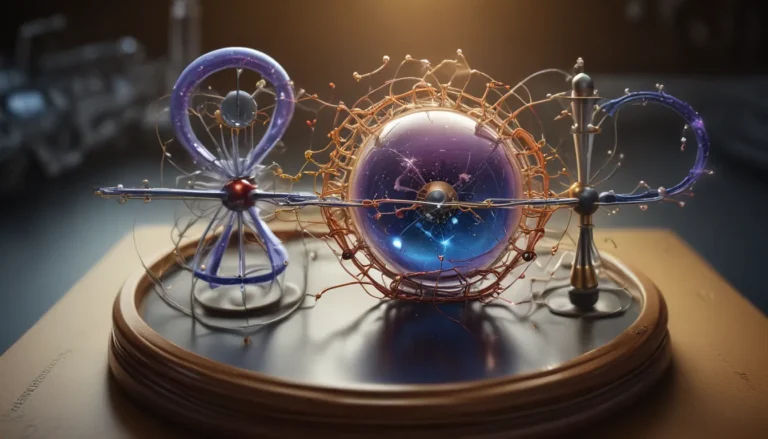A Note About Images: The images used in our articles are for illustration purposes only and may not exactly match the content. They are meant to engage readers, but the text should be relied upon for accurate information.
Classical mechanics, known as Newtonian mechanics, stands as a cornerstone in the realm of physics, unraveling the mysteries of motion and forces that govern our physical world. With its roots dating back to the genius of Sir Isaac Newton in the 17th century, classical mechanics has provided a robust framework for understanding the behavior of objects on a macroscopic scale.
Unraveling Enigmatic Insights of Classical Mechanics
Classical Mechanics at a Glance:
– Classical mechanics, the study of motion and forces, is teeming with mind-boggling facts that challenge our perception of the physical world.
– From Newton’s laws to Einstein’s groundbreaking theories, classical mechanics continues to enthrall scientists globally as they unveil the enigmatic secrets of the universe.
Einstein’s Theory of General Relativity Reshaping Perceptions:
Einstein’s revolutionary Theory of General Relativity, unveiled in 1915, shook the foundations of classical mechanics with its introduction of curved spacetime. This groundbreaking theory not only redefined our understanding of gravity but also expanded our horizons about the vast universe that surrounds us.
The Uncertainty Principle Defying Norms:
Proposed by Werner Heisenberg in 1927, the Uncertainty Principle challenges the deterministic nature of classical mechanics by asserting the impossibility of simultaneously determining the exact position and momentum of a particle. This principle injects a level of inherent uncertainty into the microscopic world, pushing the boundaries of our understanding.
Newton’s Laws: The Pillars of Classical Mechanics:
Sir Isaac Newton’s iconic three laws of motion, unveiled in his monumental work “Philosophiæ Naturalis Principia Mathematica” in 1687, serve as the bedrock upon which classical mechanics is built. These laws intricately describe the motion of objects, paving the way for deciphering and predicting the behavior of physical systems.
Diving Deeper into the Intricacies of Classical Mechanics
The Cosmic Dance of Angular Momentum:
Angular momentum, a fundamental concept in classical mechanics, governs the behavior of spinning objects. Guided by the law of conservation of angular momentum, the total angular momentum of an isolated system remains constant unless influenced by external torques. This principle is vital in comprehending the rotational motion of objects in our universe.
The Quantum Conundrum: Bridging the Gap with Quantum Mechanics:
While classical mechanics excels in portraying the motion of macroscopic objects, it falls short when explaining the behavior of subatomic particles. Quantum mechanics, emerging in the early 20th century, offers a holistic framework to understand the intricate world of particles on a microscopic scale, bringing a new perspective to the realm of physics.
The Path of Least Action: A Guiding Principle in Classical Mechanics:
The Principle of Least Action, proposed by Pierre Louis Maupertuis and further developed by eminent scholars like Leonhard Euler and Joseph-Louis Lagrange, asserts that the path taken by a particle between two points in space minimizes its action. This principle, a cornerstone of classical mechanics, plays a pivotal role in shaping our understanding of motion and dynamics.
Hamiltonian Mechanics: A Mathematical Marvel:
While Newton’s laws lay the foundation of classical mechanics, Hamiltonian mechanics offers an alternative mathematical formulation to analyze physical systems. Conceived by William Rowan Hamilton in the early 19th century, this formalism utilizes generalized coordinates and momenta to describe the dynamics of a system, offering a fresh perspective in exploring physical phenomena.
Connecting the Dots: Classical Mechanics Unraveled
The Equivalence Principle: Blurring the Lines between Gravity and Inertia:
Albert Einstein’s Equivalence Principle, a cornerstone in classical mechanics, posits that the effects of gravity mirror the effects of acceleration, blurring the distinction between the two forces. This pivotal insight laid the groundwork for Einstein’s Theory of General Relativity, reshaping our understanding of gravity as the curvature of spacetime itself.
Unveiling the Secrets of Springs: Hooke’s Law in Action:
Hooke’s Law, formulated by Robert Hooke in the 17th century, elucidates the relationship between the force exerted by a spring and its displacement from equilibrium. This fundamental law in classical mechanics facilitates the analysis of systems involving springs and elastic materials, shedding light on the behavior of these dynamic components.
Embracing the Merits of Classical Mechanics
In essence, classical mechanics stands as a captivating field of physics that continues to illuminate our understanding of motion and the interactions between objects in our universe. From the foundational principles laid down by Sir Isaac Newton to the revolutionary discoveries of Albert Einstein, classical mechanics remains a guiding beacon for further advancements in physics.
As we journey through the enigmatic realm of classical mechanics, we unearth profound insights into inertia, momentum, and gravitational forces that shape our physical world. Delving deeper into the intricacies of this fundamental branch of physics not only challenges our existing perceptions but beckons us to explore the mysteries of the universe with an unwavering curiosity.
FAQs: Unveiling the Essence of Classical Mechanics
- What is classical mechanics?
-
Classical mechanics is a branch of physics that delves into the motion of objects and the forces that govern them, establishing the foundational laws of motion by Sir Isaac Newton and offering insights into everyday physical phenomena.
-
What are the key principles of classical mechanics?
-
The key principles of classical mechanics encompass Newton’s three laws of motion, conservation of momentum, and conservation of energy, providing a robust framework to comprehend the dynamics of objects and their interactions.
-
How does classical mechanics differ from quantum mechanics?
-
Classical mechanics focuses on macroscopic objects, while quantum mechanics unravels the behavior of particles at atomic and subatomic levels. Quantum mechanics introduces a probabilistic nature, contrasting the deterministic laws of classical mechanics.
-
What are some notable applications of classical mechanics?
-
Classical mechanics finds diverse applications in engineering, robotics, astronomy, and sports, aiding in the design of efficient machines, orbit calculations for celestial bodies, and enhancing athletic performance through optimization.
-
Is classical mechanics still pertinent today?
- Undoubtedly! Despite modern physics advancements, classical mechanics remains a cornerstone in understanding the physical world. Its enduring principles find applications across varied fields, cementing its relevance in scientific and technological realms.
Understanding classical mechanics unveils a tapestry of remarkable insights that transcend conventional wisdom, enriching our perception of motion, forces, and the celestial dance of our universe. Delve into the enigmatic world of classical mechanics, where every revelation sparks a newfound appreciation for the intricate tapestry of the physical world we inhabit.






